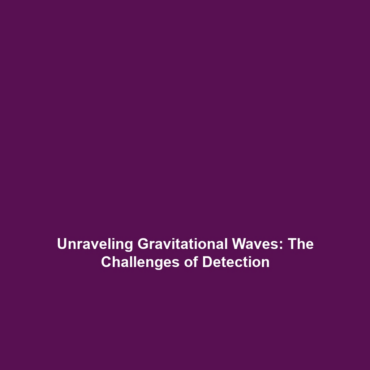Ground-based vs. Space-based Gravitational Wave Detection: Advantages and Challenges
Introduction
Gravitational waves, ripples in spacetime caused by cosmic events such as merging black holes or neutron stars, have revolutionized our understanding of the universe. The detection of these waves is essential for advancing astrophysics, and it can be achieved through two principal methods: ground-based and space-based gravitational wave detection. Each approach has its unique advantages and challenges, which significantly impact our capacity to observe and analyze gravitational waves. Understanding these differences is crucial for future research and technologies aimed at harnessing the full potential of gravitational wave astronomy.
Key Concepts
Ground-Based Detection
Ground-based gravitational wave detectors, such as LIGO (Laser Interferometer Gravitational-Wave Observatory), utilize long-baseline interferometry to capture the minute changes in distance caused by passing gravitational waves. The primary advantages include:
- Cost-Effectiveness: Ground-based observatories are generally less expensive to build and operate compared to their space counterparts.
- Accessibility: Ground-based facilities can be more easily maintained and upgraded with the latest technology.
Space-Based Detection
In contrast, space-based gravitational wave observatories like LISA (Laser Interferometer Space Antenna) promise to detect lower frequency waves, which are often missed by ground-based detectors. Advantages of space-based detection include:
- Wider Detection Range: Space-based detectors can observe gravitational waves over a broader frequency spectrum.
- Minimal Noise Levels: Operating above Earth’s atmosphere allows for a more stable and noise-free environment.
Applications and Real-World Uses
The applications of ground-based and space-based gravitational wave detection are vast and pivotal for the field of astrophysics. Understanding how these technologies are applied enhances our knowledge of cosmic phenomena. Some significant applications include:
- Astronomical Observation: Both detection methods contribute to observing events like black hole mergers and supernova explosions, providing real-time data to the scientific community.
- Testing General Relativity: Gravitational waves offer a direct means of testing theories in fundamental physics, enhancing our comprehension of gravitational forces.
Current Challenges
Despite their potential, several challenges emerge in the study and application of gravitational wave detection:
- Sensitivity Limitations: Ground-based detectors are limited by seismic and environmental noise; improvements in sensitivity are essential.
- Funding and Development: Both types of detectors require extensive funding and international collaboration, which can be difficult to secure.
- Technological Hurdles: Developing and maintaining high-precision instruments for both methodologies poses significant engineering challenges.
Future Research and Innovations
Future research in gravitational wave detection is focused on overcoming existing challenges and broadening detection capabilities. Innovations on the horizon include:
- Next-Generation Detectors: Development of advanced ground-based facilities and the deployment of space-based observatories are in the works to enhance sensitivity and detection rates.
- Data Analysis Techniques: Enhancements in algorithms for signal processing and data analysis will improve the extraction of meaningful information from noise-laden environments.
Conclusion
In summary, the dichotomy between ground-based and space-based gravitational wave detection presents both advantages and challenges critical to advancing the field of gravitational waves. Through a combination of ongoing research and technological innovations, the scientific community aims to harness the full potential of these detection methods. For more detailed insights, consider exploring related topics such as The Role of LIGO in Astrophysics and The Future of Space-Based Observatories.




